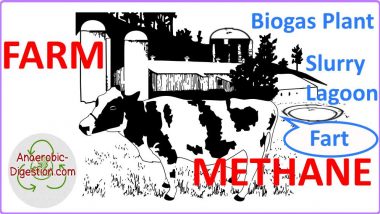In this article on Digestate Spreading we have brought together the most authoritative information on the best practice, the equipment, and the application of digestate. We start with a definition of what digestate spreading is, and we go on to cover digestate produced to PAS110 Quality Protocol standard.
That's followed by the best practice from WRAP in the UK, in the use of spreading equipment and then 3 digestate application case studies. Finally, we end this page with the digestate spreading management and storage options.
What is Digestate Spreading?
 Digestate spreading is a method of fertilisation which involves the application of a nutrient-rich product, formed through anaerobic digestion. Differing from compost which is produced through aerobic micro-organisms and requires oxygen, digestate is made up of a mix of indigestible material and dead microorganisms.
Digestate spreading is a method of fertilisation which involves the application of a nutrient-rich product, formed through anaerobic digestion. Differing from compost which is produced through aerobic micro-organisms and requires oxygen, digestate is made up of a mix of indigestible material and dead microorganisms.
This product is then applied to the field using a spreader, which is used to evenly distribute to the digestate and ensure an even spread across the ground. Digestate spreading can be used to treat nutrient-deficient soil and ensure the effective growth of crops going forward. The process and amount of digestate are determined by a test to ensure that the correct level of nutrients is inputted into the soil.
Digestate is produced through a process called anaerobic digestion, which involves a series of biological processes. During this process, microorganisms break down materials during the absence of oxygen. The materials that can be used for AD fertiliser production include biodegradable products such as food remainders, livestock slurry, and waste crops, including grasses.
Digestate can be produced to three specifications; whole, liquor, and fibre. Whole digestate slurry is typically less than 5% dry matter and is often described as similar in appearance to slurry produced from livestock. Liquor is primarily a liquid base, with most or all of the dry matter removed and fibre is more comparable to compost and composed of primarily a solid material with the whole digestate separated. via AWSM Farming
Digestate Spreading Benefits:
It’s produced to PAS110 Quality Protocol standard to:.
- Provide an excellent source of NPK and S to replace chemical fertilisers.
- Improve soil structure, drainage, water retention, and aeration, providing a better rooting environment for plants.
- Possess slow nutrient release qualities. The material continues to breakdown within the soil, reducing nitrogen and phosphate leaching.
- Improve the workability of soils, especially heavy clay.
- Improve water retention in light soils.
- Enhance resistance to soil compaction and erosion.
- Reduce the need for artificial fertilisers. via shorts-agricultural.co.uk
Digestate Spreading Equipment
The best practice is to apply digestate using a band spreader with a trailing hose or shoe, or a shallow injector. Applying digestate close to the plant roots in this way will increase the amount of nitrogen available to the crop, and reduce the amount lost to the atmosphere as polluting ammonia gas.
In contrast, broadcasting digestate with a splash-plate or similar would waste a lot of the nitrogen, with only a very small proportion becoming available to the crop. Further information on spreading equipment is available in the guidance document published by ‘WRAP Cymru Digestate: Realising the fertiliser benefits for crops and grassland’.
Using quality anaerobic digestate to benefit crops 01 Using quality anaerobic digestate to benefit crops … Digestate contains useful amounts of phosphate and potash, together. via WRAP
The main nutrients that digestate contains are nitrogen, phosphate, and potash. Additionally, there are small amounts of other beneficial elements to help keep the soil in good condition. Its high nitrogen content means it is suitable for use as a replacement for artificial fertiliser containing nitrogen.
The level of nutrients in different types of digestate will vary, however. So it is important either to carry out testing before applying it to the soil or to get full information from the supplier if the digestate is being brought in from outside your own farm.
Choosing Spreading Equipment
Like slurry, digestate can be applied by an umbilical system that allows it to be accurately targeted. This means it is pumped into the field and spread via an umbilical hose. A range of different applicators can be used, with the best choice depending on the type of digestate. Broadcast spreaders work better with fibre, while many other types of equipment, such as trailing hoses and trailing shoe, are more suitable to use with liquid or whole digestate. via Tramspread
Digestate Spreading Case Study 1 – Notes from J.M. Stratton & Co.J.M. Stratton & Co.
Our anaerobic digestion (AD) plant produces around 75,000 tonnes of nutrient-rich PAS110 compliant digestate fertiliser.
We are now spreading this on most of our arable and dairy grass across the farm. This provides all the nitrogen, phosphate, potash, and sulphur for our crops, plus a good dose of trace elements and organic matter. We test the product daily when we are spreading, and apply the right quantities to our crops in order to maximize the utilisation of the available nutrients. We have a network of storage lagoons across the farm so we can apply the digestate at exactly the right time to the crops. We spread using two appliances. Most go on using an umbilical pipe system, with a pump at the lagoon end and a 27m Vogelsang applicator boom on our John Deere tractor. This can pump up to 3,000m, using a “cow-horn” pipe management system. via J.M. Stratton & Co.
Digestate Spreading Case Study 2 – RC Baker LTD – Claas Xerion 3800 Trac VC/ Claas Xerion 3800 Saddle Trac GoPro
This is a video of RC Baker LTD spreading Digestate on all our wheat stubble using two of their amazing tankers. One is a Claas Xerion 3800 Saddle Trac with a mounted and towed tank. The boom width is 24 metres in this video to match our tramlines but they can go up to 32 metres. The second tanker is a Claas Xerion 3800 Trac VC with a trailed tanker and a 15 metre trailing shoe as the operator is just getting used to the machine as it's his second day on it. The ground which the digestate is spread on will be directly drilled with OSR and due to the high Nitrogen content, no artificial fertiliser is required at drilling.
via RC Baker LTD
Digestate Spreading Case Study 3 – Accurate Umbilical Slurry Spreading – Latest GPS System Technology
Accurate Umbilical Slurry Spreading
Once the digestate or liquid sludge has been transferred from the road tanker to the headland tank, Digestate Solutions then use the most up to date equipment and latest technology e.g. GPS System, to apply the sludges accurately providing an even application to the land.
Knowledge acquired over many years enables us to recycle digestate or sludge in the most effective way, providing excellent crop nutrition. via Accurate Umbilical Slurry Spreader
AD Digestate Storage/Spreading Management and Storage Options
Digestate is the terminology used for the bi-product of AD. However, the digestate can be managed in two ways:
1) A liquid (around 7% DM) or after separation as both a liquid (around 2.5% DM) and a dry fraction (around 25% DM) these depend on the separation equipment also (either screw press or centrifuge). Is it still digestate whether liquid or dry.
The issue over storage very much depends on the type of EA permit required:
The options are:
1) EA Permit exemption, this is for Ag plants using ag feed-stock, the only restriction is if NVZ regulations apply whereby the period of closed spreading time storage is required.
2) EA Standard permit, this applies where waste-feedstock is being used, it is a simple but inflexible permit. This has restrictions on the amount of dry fraction storage, as under this permit the dry fraction should be stored inside and usually requires some sort of Odour management.
3) EA Bespoke permit, This I can best describe as a site/area-specific permit that takes into consideration design and local area considerations. This is time-consuming and expensive but could be more flexible than a Standard permit.
The limit on storage is for the dry fraction on a standard or bespoke permit.
Finally, after separation, you may have some settlement in the liquid storage tank or the lagoon IF no agitation is provided. via TheFarmingForum





Digestate spreading COOL wheels! Awesome kit. DRAAAG machine.
I am satisfied with the idea by studying your article. But won’t spreading this muck be terribly bad smelling?
Good day,
I am from South Africa, do you have a agent in SA for a Digestate spreader ?
If not, send me detail and price please.
Please confirm availability.
Regards,
Adriaan.
Please refer to the equipment suppliers which offer this equipment by following the links within our article on this page. We act as consultants giving related AD advice. We are not an AD business offering products. Best wishes.
Adriaan
We are consultants. We don’t sell products but we can give you advice. In this instance we advise you to go to the linked websites and ask the manufacturers to provide a quote.
Thank you so much, will do so.
Regards,
Adriaan.
I appreciate your guts and decision. Your positive attitude is motivating!
Thank you. Very clear and simple explanation.